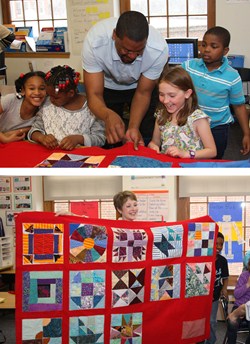Piecing Together History
 Students in Laurie Schlein’s and Derek White’s second-grade classes at Mercer are piecing together a narrative that goes something like this: “The monkey wrench turns the wagon wheel toward Canada on a bear-paw trail to the crossroads. Dress up and get married at the church, then fly like geese on the drunkard’s path to the stars.”
Students in Laurie Schlein’s and Derek White’s second-grade classes at Mercer are piecing together a narrative that goes something like this: “The monkey wrench turns the wagon wheel toward Canada on a bear-paw trail to the crossroads. Dress up and get married at the church, then fly like geese on the drunkard’s path to the stars.”
This is not a tale of their own invention; it is an elaborate series of coded messages relayed to slaves as they traveled along the Underground Railroad. Abolitionists stitched the symbolic patterns onto beautiful quilts, which they displayed strategically to provide clues for finding clothing, food, and shelter along the path to freedom in the North.
For example, the monkey wrench pattern represented the blacksmith, who started the journey. The church indicated that clothing was stored for slaves to change out of their plantation clothing. The bear-paw symbol advised slaves to follow animal tracks to find food and water; the flying geese showed the direction to travel, but not using a straight line (the drunkard’s path). As most slaves had been forbidden to learn how to read or write, the symbolic clues were critical to their safe passage.
The students learned this tradition of storytelling by creating their own clue-laden quilts, drawing upon the expert knowledge of parent volunteer and prize-winning quilter Sonia Cipiti. Her sons, Aiden and Anson, are students in those classrooms.
Cipiti’s quilting skills and her knowledge of the history of the Underground Railroad intersected at an opportune time. During Black History Month, the classes were studying an International Baccalaureate unit about how change affects the planet. Cipiti suggested to the teachers that she create a quilting project that tied in with both of those themes.
Says Schlein, “It was really nice that Sonia Cipiti was able to help us make the topic of the Underground Railroad, which could be really heavy for second grade students, much more approachable."
The students responded so enthusiastically that their quilting time has now become a weekly event. Schlein, White and Cipiti work together to weave in elements of the curriculum, such as a measurement unit from math and reading books about the time period.
For Cipiti, who has spent more than 100 hours of her time developing lesson plans and teaching the children to quilt, it has become a true labor of love. “The kids have really driven this program from the beginning,” she says. “Their enthusiasm is truly infectious, and they just love the hands-on sewing.”
The students are brimming with pride in their new skills. “This is the first time I ever did sewing, and now I know how to do it,” says one student. Another comments, “This would be a really good thing for a doctor to know how to do.”
The students learned much more than new sewing skills. “We had to be open-minded and listen to other people’s ideas when we were working together,” says one of Schlein’s students.
When the two quilts are completed, they will be displayed in the school, with a photo of their creators tucked into a special pocket lovingly stitched by the new master quilters.
Posted: Tuesday, May 6, 2014